A History of Map Monsters
-
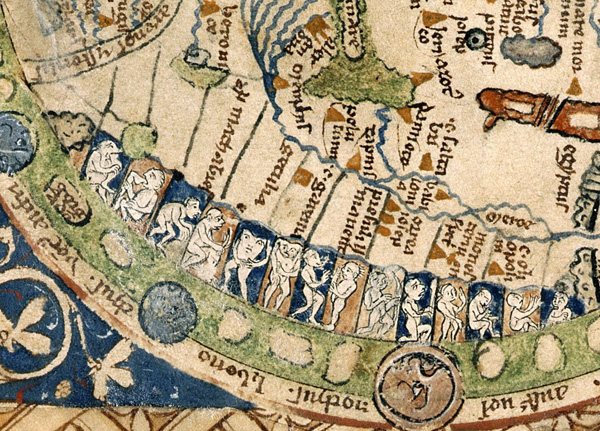
Psalter World Map, Circa 1265
In the first century A.D., Pliny the Elder recounted in his Natural History that Africa was full of remarkable tribes, including “the Nigroe, whose King hath but one eye,” “the Cynamolgi, who have Heads like Dogs,” and “the Artabatitae, who wander about like four-footed savage beasts.” These mutant races were dutifully included on maps of Africa for more than 1,000 years, though no one had ever seen them. This anonymous cartographer lined up their kingdoms neatly between the Nile, at top, and the green eastern sea, at bottom.
-
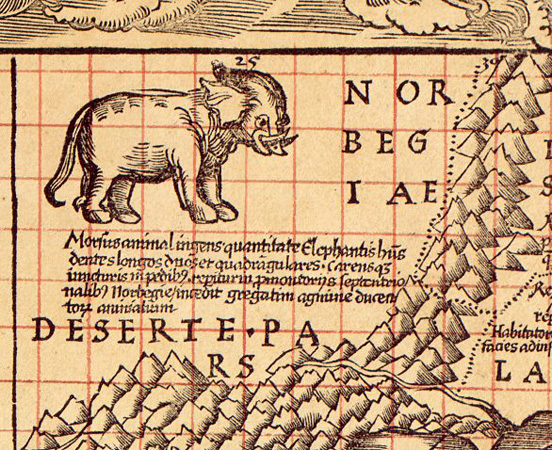
Martin Waldseemüller, Carta Marina Navigatoria, 1516
This is the second and less famous of Waldseemüller’s two great world maps; the lone surviving copy of his first, on which we see the word America first written, was bought for $10 million in 2001 by the Library of Congress. This detail depicts an odd elephant-like creature in the Arctic Ocean off of Scandinavia, possibly engraved by the artist Albrecht Dürer. The Latin text explains that this is the abode of the “morsus,” a strange animal with “large, quadrangular teeth.”
In other words, this was the artist’s conception of a walrus, based on secondhand descriptions from sailors. In most of Europe at the time, real-life creatures like walruses, giraffes, and rhinoceroses would have seemed just as fantastic as any sea serpent or dragon.
-
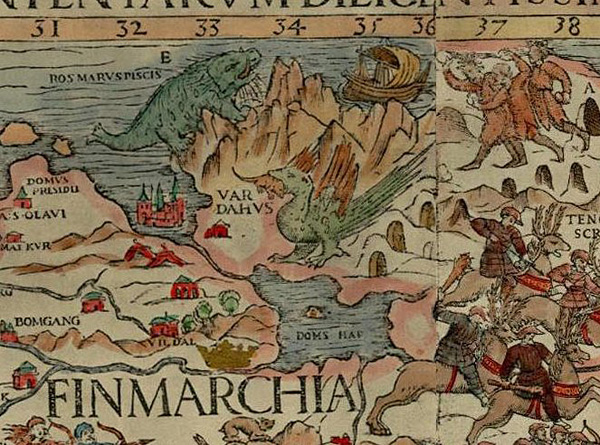
Olaus Magnus, Carta Marina, 1539
In this detail from one of our earliest maps of Scandinavia, we see the residents of Finnmark, the northernmost part of Norway. These include reindeer, Lapp hunters, a walrus (more accurate than Waldseemüller’s) climbing ashore, and what appears to be a winged dragon casually munching on a rodent. The factual mixes freely with the fanciful.
It’s a common belief that “Here be dragons” was a typical inscription on old maps. In fact, the Latin equivalent, Hic sunt dracones, has been found only once, on the 16th-century Lenox Globe, and the first scholar to study the globe, one B.F. da Costa, opined in 1879 that it referred not to mythical dragons at all, but to the “Dagroians”—a bloodthirsty Sumatran tribe described by Marco Polo. The phrase may have entered the public consciousness via the writer Dorothy Sayers, who used it in one of her Lord Peter Wimsey mysteries.
-
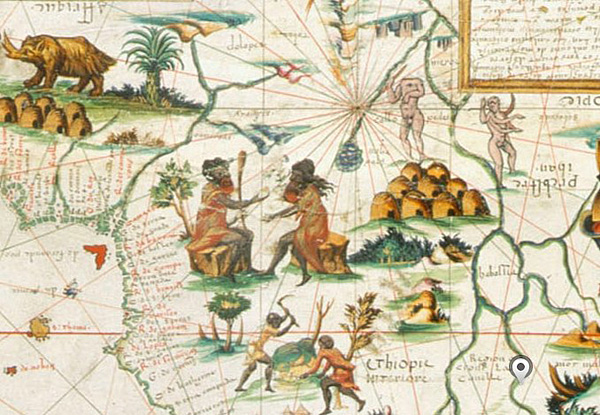
Pierre Desceliers, World Portolan, 1550
By emphasizing the strangeness of other parts of the globe, early maps helped reinforce the xenophobia of the day. People in our part of the world are normal, they say, but those elsewhere scarcely seem human. On this portolan, or navigational chart, drawn especially for King Henry II of France, the denizens of Africa get stranger and stranger the farther away they are from the coast. At the heart of the unexplored continent we see two monstrous humanoids, one with no head, the other with six arms. The two figures seated to the left are drawn more realistically, but with the exaggerated red lips of racial caricature. The man with the club is happily trading a gold nugget for a worthless flower, demonstrating the beginnings of the European belief that Africans were naive, childlike people with no ability to manage their own affairs.
-
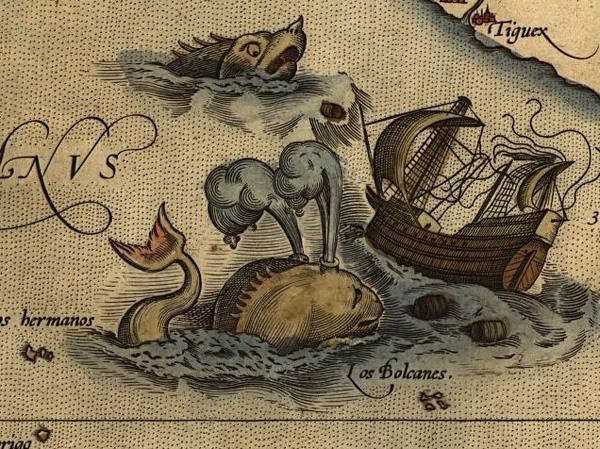
Abraham Ortelius, Theatrum Orbis Terrarum, 1570
The sea monsters on old maps appear in almost every variety imaginable: Some are armored in scales, others maned like lions or finned like giant fish. Legends of ships sunk by mighty serpents date at least back to Aristotle, who wrote, “In Libya, according to all accounts, the length of the serpents is something appalling; sailors spin a yarn to the effect that … just as they were putting out to sea, serpents came chasing their galleys at full speed and overturned one galley and set upon the crew.”
The great diversity in the sea serpents’ appearance may reflect the fact that monster stories brought home from the sea were probably exaggerated from a number of sources: whale carcasses, perhaps, or giant squid, or the rare oarfish, which can grow up to 50 feet in length.
-
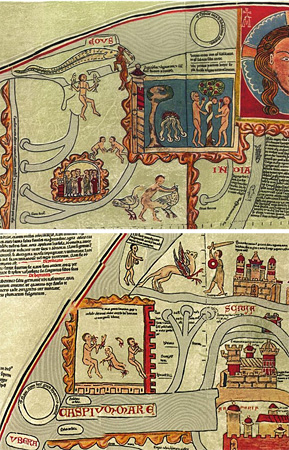
Ebstorf Mappa Mundi, 13th Century
The strangest figures on medieval maps were the ones placed there by faith. Biblical figures and legends were always included matter-of-factly—Noah’s ark perched atop Mount Ararat, Lot’s wife frozen in saline form just outside the ruins of Sodom and Gomorrah. These details are from the Ebstorf map, beautifully drawn on parchment and destroyed during the Allied bombing of Hanover in 1943. The Garden of Eden sits at the Earth’s easternmost point, near India. The square kingdom in the Caucasus is the land of the giants Gog and Magog, shown devouring human flesh. The wall keeping them locked away from us was, according to Josephus, built there by Alexander the Great himself when he discovered the barbarian kings during his campaign.
-
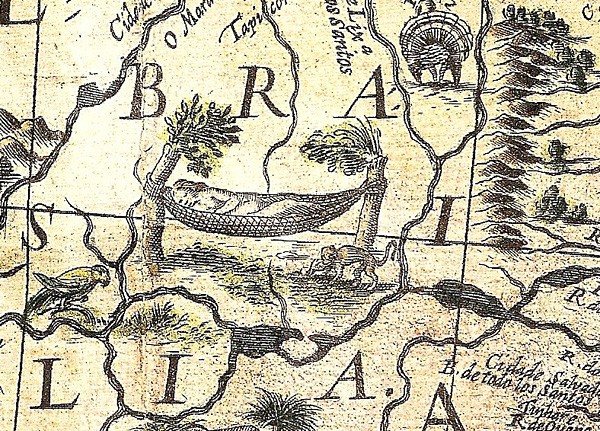
Joan Blaeu, Atlas Maior, 1686
In the Age of Empire, maps of the New World were often decorated with pictures of women, which helped reinforce the idea that these were virgin territories ready to be, well, penetrated. Here the word Brazil surrounds a drawing of an unclothed native woman sleeping peacefully in a hammock with her monkey and a parrot beside her: The Amazon symbolized by a scene of idyllic simplicity. In fact, one reason that the Americas are named for Amerigo Vespucci rather than their discoverer is that Vespucci wrote in loving detail of his crew’s libidinous exploits with the sexually liberated women of the Caribbean. As a result, his memoirs outsold Columbus’ three-to-one.
-
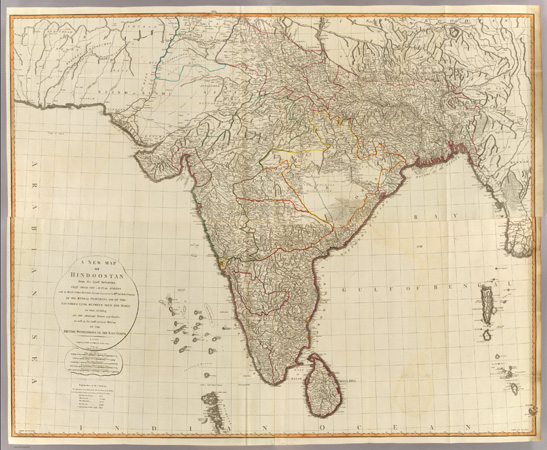
James Rennell, Map of Hindoostan, 1782
In 1733, Jonathan Swift wrote:
So geographers in Afric-maps
With Savage-Pictures fill their Gaps;
And o’er uninhabitable Downs
Place elephants for want of Towns.
He didn’t know it, but Swift was writing at the very end of the age of “Savage-Pictures” on maps. By the 18th century, more ambitious exploration and new cartographic innovations (like trigonometric surveying) meant that the blank spaces on maps were vanishing, and with them the need for strange creatures to fill them with. This tidy map of British India is full of dense, accurate detail, and the still-blank spots are left undecorated by exotic beasts, a concession to a new Age of Enlightenment in Europe.
James Rennell, who produced this map, famously called the blank spots on maps “eyesores,” and so the writing was on the wall: No terra would remain incognita for long. The age of sea serpents and other marvelous beasts on maps was over.